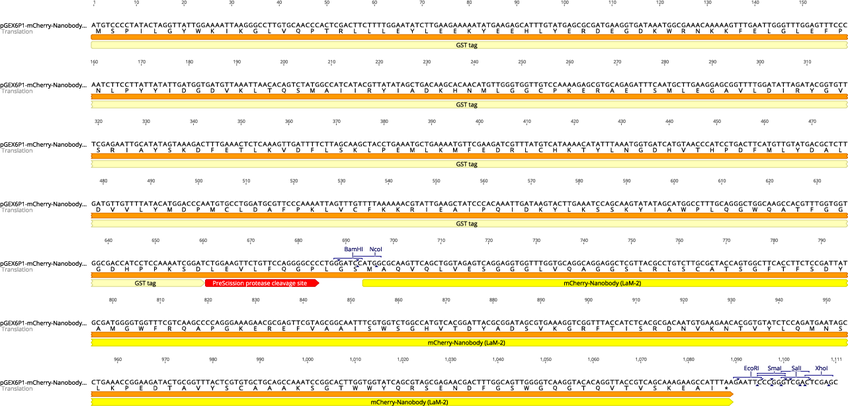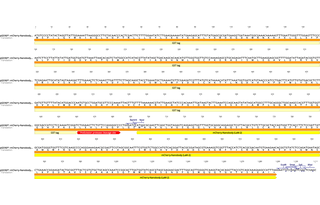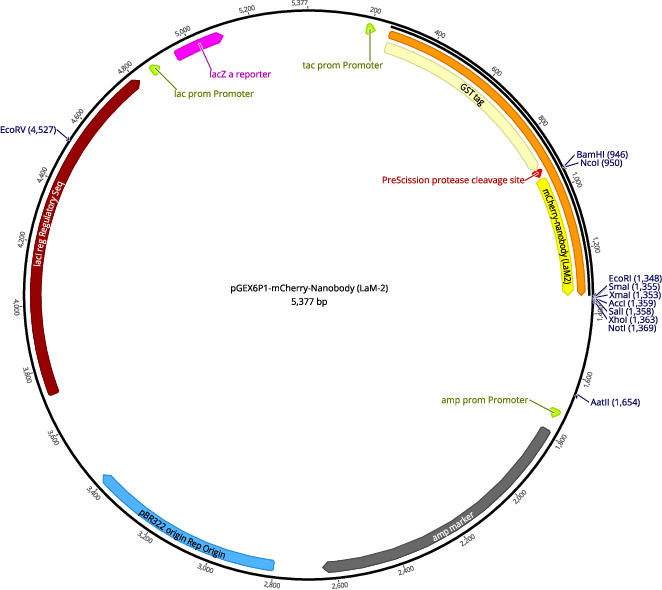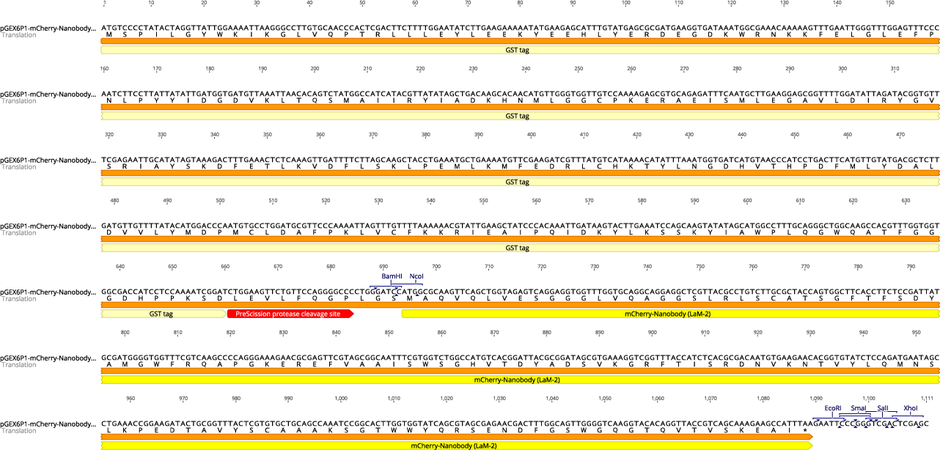-
PurposeExpresses GST-tagged anti-mCherry Nanobody (LaM-2) in E. coli cells.
-
Depositing Lab
-
Sequence Information
-
Sequences (1) — Accept Affinity Reagent Sequence Policy
-
Ordering
| Item | Catalog # | Description | Quantity | Price (USD) | |
|---|---|---|---|---|---|
| Plasmid | 162276 | Standard format: Plasmid sent in bacteria as agar stab | 1 | $85 | |
Backbone
-
Vector backbonepGEX6P1
-
Backbone manufacturerGE healthcare
- Backbone size w/o insert (bp) 5000
- Total vector size (bp) 5377
-
Vector typeBacterial Expression
Growth in Bacteria
-
Bacterial Resistance(s)Ampicillin, 100 μg/mL
-
Growth Temperature37°C
-
Growth Strain(s)DH5alpha
-
Copy numberLow Copy
Gene/Insert
-
Gene/Insert namemCherry-Nanobody (LaM-2)
-
Alt nameLaM-2
-
SpeciesLama glama
-
Insert Size (bp)396
-
Tag
/ Fusion Protein
- GST (N terminal on backbone)
Cloning Information
- Cloning method Restriction Enzyme
- 5′ cloning site BamHI (not destroyed)
- 3′ cloning site EcoRI (not destroyed)
- 5′ sequencing primer CGTATTGAAGCTATCCCAC
- 3′ sequencing primer CGGCATCCGCTTACAGAC (Common Sequencing Primers)
Resource Information
-
A portion of this plasmid was derived from a plasmid made bymCherry-Nanobody (LaM-2) was originally developed by Dr. Rout et al. (see citation in the comments section)
-
Article Citing this Plasmid
Terms and Licenses
-
Academic/Nonprofit Terms
-
Industry Terms
- Not Available to Industry
Trademarks:
- Zeocin® is an InvivoGen trademark.
Depositor Comments
Additional citation: Fridy PC, Li Y, Keegan S, Thompson MK, Nudelman I, Scheid JF, Oeffinger M, Nussenzweig MC, Fenyö D, Chait BT & Rout MP (2014) A robust pipeline for rapid production of versatile nanobody repertoires. Nat Meth 11: 1253–1260
These plasmids were created by your colleagues. Please acknowledge the Principal Investigator, cite the article in which the plasmids were described, and include Addgene in the Materials and Methods of your future publications.
-
For your Materials & Methods section:
pGEX6P1-mCherry-Nanobody (LaM-2) was a gift from Kazuhisa Nakayama (Addgene plasmid # 162276 ; http://n2t.net/addgene:162276 ; RRID:Addgene_162276) -
For your References section:
Molecular basis of ciliary defects caused by compound heterozygous IFT144/WDR19 mutations found in cranioectodermal dysplasia. Ishida Y, Kobayashi T, Chiba S, Katoh Y, Nakayama K. Hum Mol Genet. 2021 Apr 26;30(3-4):213-225. doi: 10.1093/hmg/ddab034. 10.1093/hmg/ddab034 PubMed 33517396









